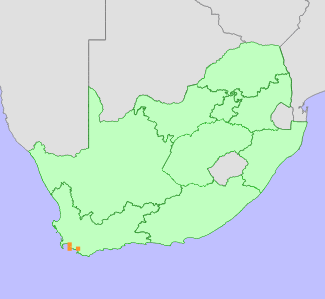|
Scientific Name | Mimetes hottentoticus E.Phillips & Hutch. |
Higher Classification | Dicotyledons |
Family | PROTEACEAE |
Common Names | Matchstick Pagoda (e) |
National Status |
Status and Criteria | Vulnerable D2 |
Assessment Date | 2020/06/15 |
Assessor(s) | A.G. Rebelo, D. Raimondo & L. von Staden |
Justification | Mimetes hottentoticus is a restricted mountain fynbos endemic occurring only on the Kogelberg Mountain in South Africa. It has an extent of occurrence (EOO) and area of occupancy (AOO) of 44 km². It is known from one threat defined location and is potentially threatened by too frequent fire, Phytophthora infection and invasive alien plant species. It therefore qualifies for listing as Vulnerable under criterion D. |
Distribution |
Endemism | South African endemic |
Provincial distribution | Western Cape |
Range | This species is known from Kogelberg Mountain, in the Western Cape Province of South Africa. |
Habitat and Ecology |
Major system | Terrestrial |
Major habitats | Kogelberg Sandstone Fynbos |
Description | It occurs in seeps on upper south-facing sandstone slopes, at 1000-1260 m.a.s.l. Mature individuals are killed by fires, and only seeds survive. Seeds are released after ripening, and dispersed by ants to their underground nests, where they are protected from predation and germinate following fire. It is pollinated by birds. The seed ecology is not well understood, there has been evidence that this species has long lived seedbanks, as a dense population that was killed by an early fire before setting seed recovered from soil-stored seed banks at a similar density to that before the previous fire (M. Johns, Kogelberg Reserve Manager pers. comm.). It therefore appears that a considerable proportion, perhaps over half, of the seed bank might not germinate after a fire. If this is the case, then the generation times for these species is likely to be two or three fire cycles, but this depends on the rate of decay of the seed bank, which is unknown. |
Threats |
| This restricted mountain endemic is susceptible to too frequent fires, the fire records from the past 30 years show that most of its restricted range has burnt at natural fire intervals with two fires burning different sections of the population in 1990 and 1995 and the whole population burnt in 2008. Less than 5% of the range parts of Kogelberg Peak also burnt in 2019, an 11 year fire interval. As this species has long lived soil seedbanks it can survive a few short fire cycles however it remains vulnerable to too frequent fire if these occur repeatedly in the future. Furthermore it is potentially threatened by the spread of invasive alien plants which thus far have been kept at bay due to excellent management of the Kogelberg Nature Reserve over the past 30 years, however management of this reserve changed in 2019 and it is possible that aliens will spread into the reserve in the future. It is also susceptible to Phytophthora infection. |
Population |
Occurring over a 6.5 km long range in a fairly continuous population of about a dozen patches. Only on Kogelberg Peak do numbers exceed 100 plants, with elsewhere several stands of only one plant occur. Protea atlas data collected between 1994 and 2002 suggest an upper limit of 1 500 plants. There has not been extensive monitoring of this species but a handful of stands some numbering over 100 plants have been monitored since 2015 on iNaturalist. Numbers fluctuate between 300 and 1500 plants, depending on veld age and fire patterns however since this species has long lived soil seedbanks severe fluctuations are not applicable. The population trend is suspected to be stable.
|
Population trend | Stable |
Conservation |
| It is confined to the Kogelberg Nature Reserve and Steenbras Catchment Area. |
Assessment History |
Taxon assessed |
Status and Criteria |
Citation/Red List version | | Mimetes hottentoticus E.Phillips & Hutch. | CR B1ac(iv) | Raimondo et al. (2009) | | Mimetes hottentoticus E.Phillips & Hutch. | Rare | Hilton-Taylor (1996) | | Mimetes hottentoticus E.Phillips & Hutch. | Endangered | Hall et al. (1980) | |
Bibliography |
Goldblatt, P. and Manning, J.C. 2000. Cape Plants: A conspectus of the Cape Flora of South Africa. Strelitzia 9. National Botanical Institute, Cape Town.
Hall, A.V., De Winter, M., De Winter, B. and Van Oosterhout, S.A.M. 1980. Threatened plants of southern Africa. South African National Scienctific Programmes Report 45. CSIR, Pretoria.
Hilton-Taylor, C. 1996. Red data list of southern African plants. Strelitzia 4. South African National Botanical Institute, Pretoria.
Manning, J.C. and Goldblatt, P. 2012. Plants of the Greater Cape Floristic Region 1: The Core Cape Flora. Strelitzia 29. South African National Biodiversity Institute, Pretoria.
Raimondo, D., von Staden, L., Foden, W., Victor, J.E., Helme, N.A., Turner, R.C., Kamundi, D.A. and Manyama, P.A. 2009. Red List of South African Plants. Strelitzia 25. South African National Biodiversity Institute, Pretoria.
Rebelo, T. 2001. Sasol Proteas: A field guide to the proteas of southern Africa. (2nd ed.). Fernwood Press, Vlaeberg, Cape Town.
|
Citation |
| Rebelo, A.G., Raimondo, D. & von Staden, L. 2020. Mimetes hottentoticus E.Phillips & Hutch. National Assessment: Red List of South African Plants version 2024.1. Accessed on 2025/12/02 |
 Comment on this assessment
Comment on this assessment

